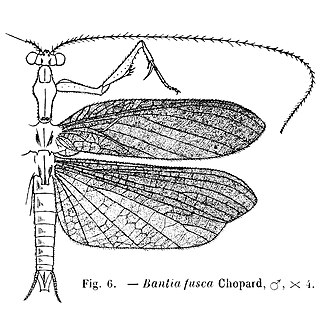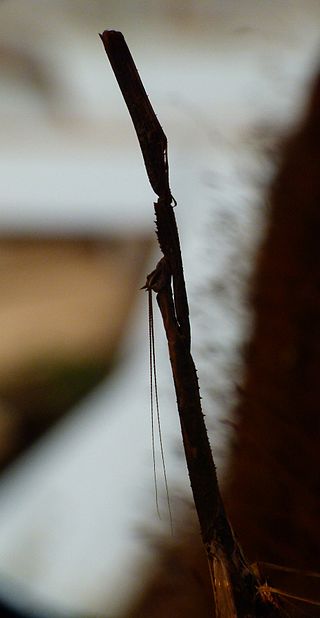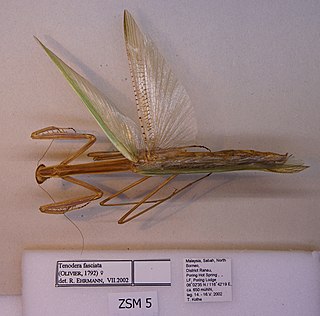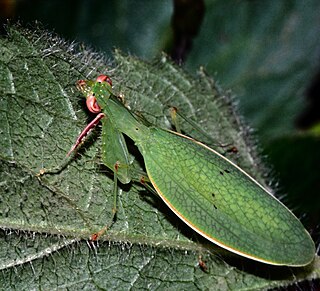
Mantidae is one of the largest families in the order of praying mantises, based on the type species Mantis religiosa; however, most genera are tropical or subtropical. Historically, this was the only family in the order, and many references still use the term "mantid" to refer to any mantis. Technically, however, "mantid" refers only to members of the family Mantidae, and not the numerous remaining families of mantises. Some of the most recent classifications have promoted a number of the mantid subfamilies to the rank of family, e.g. Iridopterygidae, Sibyllidae, Tarachodidae, Thespidae, and Toxoderidae, while other classifications have reduced the number of subfamilies without elevating them to higher rank.

Hymenopodidae is a family of the order Mantodea (mantises), which contains six subfamilies. Some of the species in this family mimic flowers and are found camouflaged among them; these are called flower mantises. Their coloration is aggressive mimicry, luring prey to approach close enough to be seized and eaten.

Tenodera is a genus of mantis in the family Mantidae which contains several species of praying mantises. The species in this genus can be found primarily in Africa, Asia and Australia, but also North America.

Acromantinae is a subfamily of the mantis family Hymenopodidae which contains two tribes and about 13 genera.

Amantis is a genus of praying mantids native to Asia and the islands of the Pacific Ocean and now belongs to the monotypic tribe Amantini of the subfamily Iridopteryginae.
Hierodula schultzei is a species of praying mantis in the family Mantidae.
Hierodula sorongana is a species of praying mantis in the family Mantidae.
Hierodula werneri is a species of praying mantis in the family Mantidae.

Thespidae is a family of insects in the order Mantodea. Following a major revision of this order in 2019, the old-world subfamilies Haaniinae and Hoplocoryphinae, previously placed here, have been upgraded to family level. Thespidae are mostly Neotropical and few species have reached the Nearctic realm.

Toxoderidae is a family of praying mantises.

Tenodera aridifolia, the Japanese giant mantis, is a species of mantis in the subfamily Mantinae. The Chinese mantis, T. sinensis, was once considered to be a subspecies of T. aridifolia, but the species can be distinguished by the shape of male genitalia.

Tenodera fasciata is a species of mantis in the family Mantidae.
Deroplatyini is a tribe of the subfamily Deroplatyinae of the family Mantidae of Mantodea.

Orthodera is a genus of praying mantises that can be found in Australia and Southeast Asia, with one species said to be the only native species of mantis of New Zealand.

The Hierodulinae are a subfamily of praying mantids, originally used by Brunner von Wattenwyl. It was restored as part of a major revision of mantid taxonomy, and now contains genera previously placed elsewhere in the family Mantidae.

The Nanomantidae are a new (2019) family of praying mantises, based on the type genus Nanomantis. As part of a major revision of mantid taxonomy, genera and tribes have been moved here, substantially replacing the old family Iridopterygidae.

The Gonypetidae are a new (2019) family of praying mantids, based on the type genus Gonypeta. The name was created by Westwood and it has been revived as part of a major revision of mantid taxonomy; the subfamily Iridopteryginae having been moved here from the obsolete family Iridopterygidae. The Gonypetinae include Asian genera transferred from the obsolete taxa Amelinae and Liturgusidae.
Dactylopterygidae is a family of praying mantises, based on the type genus Dactylopteryx. The first use of "Dactylopterygidae" was by Giglio-Tos and it has recently (2019) been revived as part of a major revision of mantis taxonomy; three genera have been separated from others in the subfamily Liturgusinae and moved here from the family Liturgusidae.
The Chroicopteridae are a family of praying mantids, based on the type genus Chroicoptera. The name is derived from first use, for subfamily Chroicopterinae, by Giglio-Tos and it has been revived as part of a major revision of mantid taxonomy. Some genera have also been moved here from the tribe Rivetinini, with others placed elsewhere including the subfamily Miomantinae.

The Tenoderinae are a subfamily of praying mantids, originally used by Brunner von Wattenwyl. It was restored as part of a major revision of mantid taxonomy, and contains many genera previously placed in the subfamily Mantinae.














